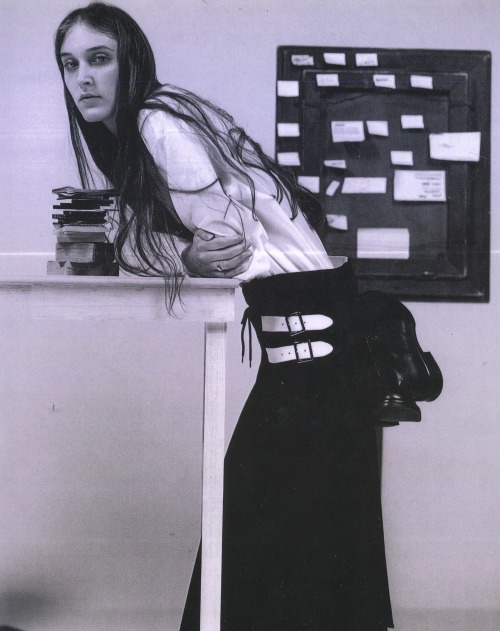Despite first establishing his own label in Japan back in 1972, it was not until 1981 that Yohji Yamamoto made his international debut, showcasing the first collection of his eponymous label in Paris. The collection garnered massive amounts of column inches within the fashion press - in stark contrast to the body-conscious, high-glamour collections of the time, Yamamoto sent all of his models down the runway in black asymmetric clothing and dramatic white make-up. The use of loose fabrics, oversized silhouettes and a monochromatic colour palette would establish the aesthetic for which Yamamoto would become renowned; an aesthetic which the designer has experimented with and developed over his thirty-year career. The aesthetic was also the first consistent example of a 'minimal' collection, and was the first notable example of minimalism truly engulfing the mainstream and being seen as a more commercially viable option that traditional glamour.
 |
| Yohji Yamamoto A/W 1996 |
Whilst the collection itself was interesting, it was the reaction of the fashion media that was the real talking point. The show marked the beginning of the 'Japanese invasion' and, essentially, a new era in fashion. Accompanied by Rei Kawakubo and Issey Miyake, the powerful trio baffled the media by creating designs that were deliberately designed to avoid being 'flattering'. The lines of the clothing never seemed to match the female form,and almost seemed to enshroud the figure rather than accentuate it. The collection was a feminist statement in some way - it showed that clothes could look good on a woman without being figure-hugging.
The collection also came at a pivotal time, in the sense that the 80s were the decade in which high-powered females started to dominate the business world. For the first time, women weren't pressured to sexualise their image, and Yamamoto's collection was the first example of a backlash towards the hyper-feminine aesthetic that was the go-to look of the fashion world at the time.
 |
| Yohij Yamamoto A/W 1985 |
More importantly, Yamamoto essentially opened the floodgates for experimentality - for several years fashion adopted an avant-garde mentality to garment design as opposed to manufacturing clothing with commercial appeal. Ironically, the collection and the designer himself became extremely successful with the mainstream; even in 2007, Yohji Yamamoto Inc. reported that his combined lines grossed more than $100million each year.
 |
| Image taken from the Yohij Yamamoto catalogue, A/W 1999 |
Overall, the designer and his Eastern contemporaries were perhaps the reason that minimalism has been allowed into mainstream society as much as it has. They were the first designers to rebel against glamour and create clothing that made people question its worth. More importantly, their clothing represented a true breakthrough in the world of fashion and revolutionised attitudes towards women and their clothing choices. They also empowered women by giving them the option to dress in a manner that wasn't geared towards showcasing their figure and presenting an alternative to mainstream society's concept of 'high fashion'.
 |
| Image taken from the Yohji Yamamoto catalogue, 2000 |
 |
| Yohji Yamamoto A/W 1987, photographed by Nick Knight |





No comments:
Post a Comment